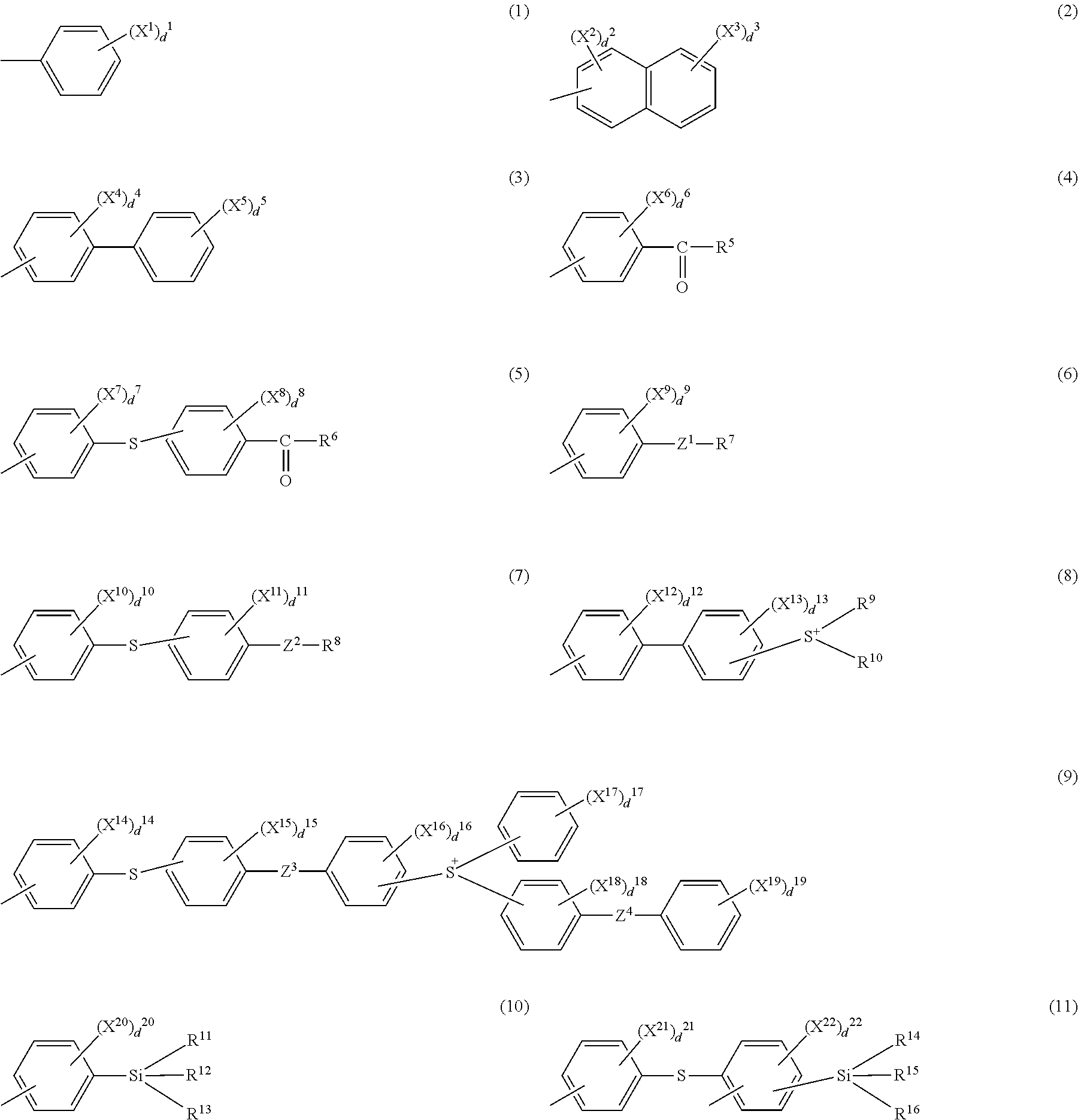Resin composition for optical stereolithography
a technology of optical stereolithography and composition, applied in the direction of instruments, photomechanical devices, coatings, etc., can solve the problems of low catalytic activity, insufficient physical properties of stereolithographic products, and the need for extreme care of antimony compound handling, etc., to achieve excellent safety and handling properties, reduce yellowness, and high heat resistance
- Summary
- Abstract
- Description
- Claims
- Application Information
AI Technical Summary
Benefits of technology
Problems solved by technology
Method used
Image
Examples
example 1
[0208](1) 3,4-epoxycyclohexylmethyl-3′,4′-epoxycyclohexane carboxylate (“Cel-2021P” manufactured by DAICEL CORPORATION), 6.5 parts by mass, hydrogenated bisphenol A diglycidylether (“HBE-100” manufactured by New Japan Chemical Co., Ltd.), 30 parts by mass, an aromatic triglycidylether compound (A-2b) represented by the above chemical formula (A-21b) [2-[4-(2,3-epoxypropoxy)phenyl]-2-[4-[1,1-bis[4-([2,3-epoxypropoxy]phenyl]ethyl]phenyl]propane] (“VG3101L” manufactured by Printech co., ltd.), 30 parts by mass, 3-ethyl-3-hydroxymethyloxetane (“OXT101” manufactured by TOAGOSEI CO. LTD.) 7.5 parts by mass, bis(-ethyl-(3-oxetanylmethyl)ether “OXT221” manufactured by TOAGOSEI CO., LTD.) 15 parts by mass, 1,6-hexanediol diglycidylether (“EX-212” manufactured by Nagase ChemteX Corporation) 3 parts by mass, dipentaerythritol pentaacrylate (“A-9550W” manufactured by Shin Nakamura Chemical Co., Ltd.) 10 parts by mass, lauryl acrylate (“NKester-LA” manufactured by Shin Nakamura Chemical Co., Ltd...
example 2
[0212](1) A resin composition for optical stereolithography was prepared in the same manner as in Example 1 (1), except that Methyl Violet 10B (“Crystal Violet” manufactured by Wako Pure Chemical Industries, Ltd.) 2.5×10−5 parts by mass (based on the mass of a resin composition for optical stereolithography, 0.21 ppm) was further added in Example 1 (1). Viscosity of thus obtained resin composition for optical stereolithography was measured to be 608 mPa·s by the above-described method.
[0213](2) Using the resin composition for optical stereolithography obtained in the above (1), a specimen for measurement of physical properties was prepared in the same manner as in Example 1 (2), and the resulting specimen was heated at 100° C. for 2 hours to post-cure. Mechanical properties, heat deflection temperature, yellowness and whole light transmittance of the specimen after post-curing were measured by the above-described method.
[0214]The results are shown in Table 1 below.
example 3
[0215](1) A resin composition for optical stereolithography was prepared in the same manner as in Example 1 (1), except that the added amount of 1,6-hexanediol diglycidylether was changed to 2.0 parts by mass, the added amount of polytetramethylene ether glycol was changed to 2.0 parts by mass, and the added amount of 1,6-hexanediol was changed to 2.0 parts by mass in Example 1 (1). Viscosity of thus obtained resin composition for optical stereolithography was measured to be 604 mPa·s by the above-described method.
[0216](2) Using the resin composition for optical stereolithography obtained in the above (1), a specimen for measurement of physical properties was prepared in the same manner as in Example 1 (2), and the resulting specimen was heated at 100° C. for 2 hours to post-cure.
[0217]Mechanical properties, heat deflection temperature, yellowness and whole light transmittance of the specimen after post-curing were measured by the above-described method.
[0218]The results are shown ...
PUM
| Property | Measurement | Unit |
|---|---|---|
| wavelength | aaaaa | aaaaa |
| temperature | aaaaa | aaaaa |
| thickness | aaaaa | aaaaa |
Abstract
Description
Claims
Application Information
 Login to View More
Login to View More - R&D
- Intellectual Property
- Life Sciences
- Materials
- Tech Scout
- Unparalleled Data Quality
- Higher Quality Content
- 60% Fewer Hallucinations
Browse by: Latest US Patents, China's latest patents, Technical Efficacy Thesaurus, Application Domain, Technology Topic, Popular Technical Reports.
© 2025 PatSnap. All rights reserved.Legal|Privacy policy|Modern Slavery Act Transparency Statement|Sitemap|About US| Contact US: help@patsnap.com



